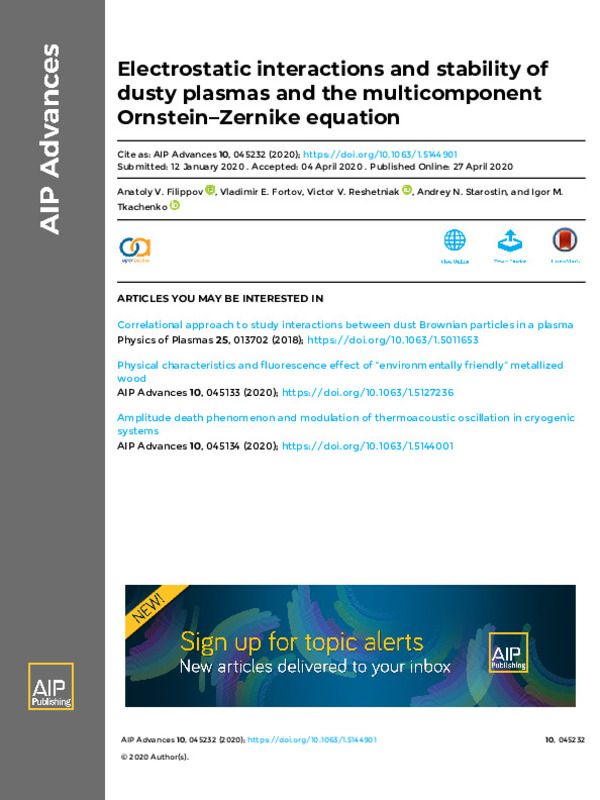JavaScript is disabled for your browser. Some features of this site may not work without it.
Buscar en RiuNet
Listar
Mi cuenta
Estadísticas
Ayuda RiuNet
Admin. UPV
Electrostatic interactions and stability of dusty plasmas and the multicomponent Ornstein-Zernike equation
Mostrar el registro sencillo del ítem
Ficheros en el ítem
| dc.contributor.author | Tkachenko Gorski, Igor Mijail
|
es_ES |
| dc.contributor.author | Filippov, A.V.
|
es_ES |
| dc.contributor.author | Fortov, Vladimir E.
|
es_ES |
| dc.contributor.author | Reshetniak, V.V.
|
es_ES |
| dc.contributor.author | Starostin, A.N.
|
es_ES |
| dc.date.accessioned | 2023-07-10T18:02:14Z | |
| dc.date.available | 2023-07-10T18:02:14Z | |
| dc.date.issued | 2020-04 | es_ES |
| dc.identifier.issn | 2158-3226 | es_ES |
| dc.identifier.uri | http://hdl.handle.net/10251/194766 | |
| dc.description.abstract | [EN] Using the Ornstein-Zernike integral fluid equation for multi-component plasma, the dielectric properties and thermodynamical stability of dusty plasmas are studied. For the most non-ideal dust plasma subsystem, a transition to the one-component approximation is carried out. It is shown that the effective pseudopotential for determining the correlation functions in the selected subsystem should not include the contribution of this subsystem to the screening constant but also take into account the condition of total plasma quasineutrality. It is demonstrated that when the coupling parameter of the dust subsystem is smaller than unity, Gamma(00) < 1, the interaction potential between the charged plasma particles is fairly well described by the Debye potential with a full screening constant. For Gamma(00) > 1, the static dielectric function in the long wavelength domain becomes negative, and this domain expands when Gamma(00) increases. This leads to the appearance of attraction of particles with charges of the same sign and repulsion of particles with charges of the opposite sign. In this case, both the total pressure and the isothermal compressibility in the entire studied range of the coupling parameter Gamma(00) < 250 remain positive, but the isothermal compressibility of the dust subsystem becomes negative at Gamma(00) approximate to 2 within the studied range of variation of the plasma parameters. The sign of the derivative of the chemical potential with respect to the total number of dust particles, the positiveness of which is the third condition for the thermodynamic stability, is shown to coincide with the sign of the isothermal compressibility of the dust subsystem. Therefore, it is concluded that the equilibrium dusty plasma at Gamma(00) > 2 is thermodynamically unstable. | es_ES |
| dc.description.sponsorship | This study was developed within Project No. 16-12-10424 supported by the grant from the Russian Science Foundation, and the numerical simulations were carried out as a part of the State assignment financed by the Ministry of Science and Higher Education of the Russian Federation (Project No. 0038-2019-0005). | es_ES |
| dc.language | Inglés | es_ES |
| dc.publisher | American Institute of Physics | es_ES |
| dc.relation.ispartof | AIP Advances | es_ES |
| dc.rights | Reserva de todos los derechos | es_ES |
| dc.subject | Dusty plasmas | es_ES |
| dc.subject | Thermodynamics | es_ES |
| dc.subject | Stability | es_ES |
| dc.subject.classification | MATEMATICA APLICADA | es_ES |
| dc.title | Electrostatic interactions and stability of dusty plasmas and the multicomponent Ornstein-Zernike equation | es_ES |
| dc.type | Artículo | es_ES |
| dc.identifier.doi | 10.1063/1.5144901 | es_ES |
| dc.relation.projectID | info:eu-repo/grantAgreement/RSF//16-12-10424/ | es_ES |
| dc.relation.projectID | info:eu-repo/grantAgreement/Ministry of Science and Higher Education of the Russian Federation//0038-2019-0005/ | es_ES |
| dc.rights.accessRights | Abierto | es_ES |
| dc.contributor.affiliation | Universitat Politècnica de València. Escuela Técnica Superior de Ingenieros Industriales - Escola Tècnica Superior d'Enginyers Industrials | es_ES |
| dc.description.bibliographicCitation | Tkachenko Gorski, IM.; Filippov, A.; Fortov, VE.; Reshetniak, V.; Starostin, A. (2020). Electrostatic interactions and stability of dusty plasmas and the multicomponent Ornstein-Zernike equation. AIP Advances. 10(4):1-14. https://doi.org/10.1063/1.5144901 | es_ES |
| dc.description.accrualMethod | S | es_ES |
| dc.relation.publisherversion | https://doi.org/10.1063/1.5144901 | es_ES |
| dc.description.upvformatpinicio | 1 | es_ES |
| dc.description.upvformatpfin | 14 | es_ES |
| dc.type.version | info:eu-repo/semantics/publishedVersion | es_ES |
| dc.description.volume | 10 | es_ES |
| dc.description.issue | 4 | es_ES |
| dc.relation.pasarela | S\425011 | es_ES |
| dc.contributor.funder | Russian Science Foundation | es_ES |
| dc.contributor.funder | Ministry of Science and Higher Education of the Russian Federation | es_ES |








